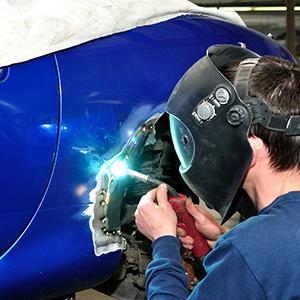We’ve all seen PAPR headgear. Those helmets with the tubes like your scuba diving on land. And yet, not a lot of welders know when or why you might need to use a PAPR.
What the heck is a PAPR?
A PAPR is essentially an electric-powered gasmask. It stands for “Powered Air Purifying Respirator.” This is the same technology that doctors and nurses use while treating outbreaks of contagious diseases. Most welding PAPRs also provide cool air to a welder’s breathing zone, keeping them from overheating while on the job.
PAPRs work by pulling contaminated air through an intake valve on a belt the welder wears. The air is pushed through a filter which traps contaminants, cleaning the air. The now clean air is then pumped up to the welder’s face. Each PAPR system has a level of protection rating which dictates the type of conditions it should be used in.

When should you use a PAPR system?
Within the last several decades, it’s become much more obvious how welding in unventilated environments can have negative health effects in the long term. Researchers found that a welder working 8-hour days can inhale up to 11 grams of carbon steel a year. And that’s just working with normal, non-toxic materials.
The actual negative health effects vary depending on the material you use. Metal fume fever is one of the most common, an injury with several names including brass shakes, galvie flu, and Monday morning fever. By welding galvanized material, you create poisonous fumes your body breathes in when you don’t have enough ventilation or protection. Metal fume fever starts with flu like symptoms that actually often get misdiagnosed as the normal flu. It’s nasty stuff and if you continue to be exposed, it ultimately can lead to death in a most painful way.
When society became more aware of the negative effects of welding fumes, OSHA mandated certain levels of protection that welders must have depending on their environment. Because of this, every PAPR has an OSHA APF (assigned protection factor). In order to legally weld in some industries/situations, you must have adequate protection. This is why a lot of welders use PAPRs for work.

Breathing in your weld fumes like this isn't ideal, especially if you're working with treated materials.
But if you don’t have an employer or OSHA telling you to use a PAPR, how do you know if you need one? Let’s consider the physics of the situation. Breathing in welding exhaust fumes is bad (or even deadly depending on the material). So, if you’re repeatedly breathing in your fumes, you’re going to end up like one of those people on the anti-smoking commercials sipping applesauce through a hole in your neck. You’ve got to get welding fumes away from your mouth.
For many welders, just having a ventilated space is a good start. Open windows, turn on fans, weld outside if you have no other option. However, if you’re working with more hazardous material such as galvanized steel or within a closed space (or both), you really do need to look into a PAPR. Welding is an incredible career or hobby but a terrible grim reaper. It’s important to take your health seriously.
Right now, Miller is highlighting their PAPR T94-R welding helmet. It’s a top-notch piece of equipment designed to maximize your productivity, while reducing weld fume exposure with a well-balanced, lightweight. Here's what's really worth writing home about when it comes to the T94-R:
ClearLightTM Lens Technology allows more natural, accurate colors to come through, optimizing contrast and clarity between the weld and the workpiece for better quality welds and less rework.
Patent-Pending DualTecTM Manifold six point air distribution system allows operators to customize the airflow to targeted areas of the face – reducing dry eyes and noses and maximizing comfort.
Lightweight, Low-Profile Blower assembly with integrated shoulder straps which reduces lower back strain and fatigue.
Exclusive X-ModeTM Technology which electromagnetically senses the weld to eliminate sunlight interference and continuously detects the arc even if sensors are blocked. Perfect for outdoor welding, out of position welding and low-amp TIG welding.
For more info about the T94-R, check out the video below






